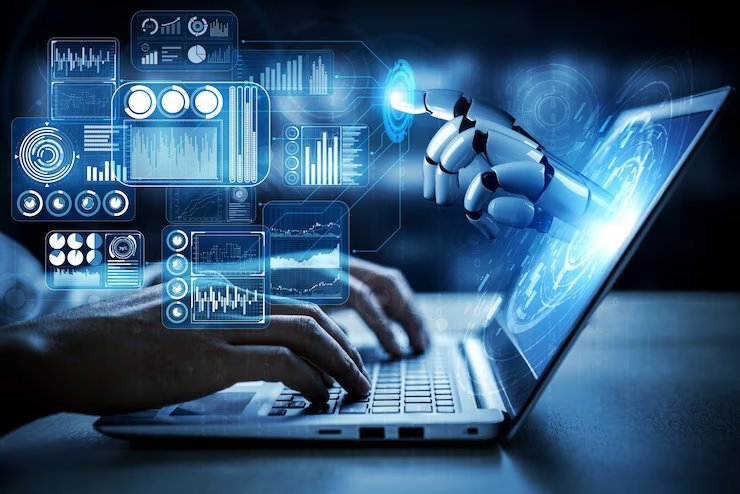Hey there, digital adventurers! Ready to dive into the whirlpool of web wonderment? We’re about to unravel the fascinating saga of how Web 2.0 flipped the online world on its head and transformed our virtual playgrounds into immersive wonderlands. So, buckle up your broadband belts and let’s surf through the evolution of online experiences!
1. Unleashing Web 2.0 – From Static To Dynamic
Remember the good old days of dial-up connections and static websites? Well, hold on to your nostalgia hats because Web 2.0 crashed the party! It’s like the difference between watching a silent movie and experiencing a 3D blockbuster. Web 2.0 kicked those clunky, one-way conversations to the curb and introduced a dynamic, two-way interaction. Think of it as upgrading from a typewriter to a voice-activated AI text generator.
2. Interactivity Galore – The Rise Of User-Generated Content
Web 2.0 transformed us from passive consumers into active contributors. Suddenly, we weren’t just reading articles; we were commenting, sharing, and even creating content ourselves. Social media platforms like Facebook, YouTube, and Twitter became our digital megaphones. It’s like going from scribbling in the sand to broadcasting on the moon.
3. From Websites To Web Applications – The App Revolution

With Web 2.0, websites turned into web applications. We no longer just browsed; we engaged. Online shopping became an experience, not just a transaction. It’s like going from window shopping to trying on a virtual dress and having a digital shopping assistant help you pick accessories.
4. Collaboration Nation – The Power Of Crowdsourcing
Remember when working together on a project meant sitting in the same room? Web 2.0 changed the game with collaborative tools like Google Docs, where you could be continents apart and still create magic together. It’s like having a never-ending virtual brainstorming session with colleagues from around the world.
5. The Social Media Storm – Redefining Connectivity
Social media platforms stormed in with Web 2.0, connecting long-lost friends, sparking revolutions, and turning everyone into a global news outlet. It’s like attending a never-ending digital cocktail party where everyone’s thoughts are on display, and you’re free to join any conversation.
6. From Consumers to Prosumers – Shaping The Digital Landscape
Web 2.0 blurred the lines between consumers and producers. We became “prosumers,” shaping products and services through our feedback and reviews. It’s like having a backstage pass to a concert where your opinion influences the playlist.
7. The App Store Ecosystem – Apps For Every Whim

App stores exploded with Web 2.0, offering everything from productivity enhancers to games that let you slingshot birds at pigs. It’s like having a virtual genie that fulfills every digital desire you can think of.
- The Mobile Revolution – Web 2.0 on the Go : Remember when the internet was confined to your desktop? Web 2.0 broke those chains with the mobile revolution. Now, you could order food, read news, and watch videos while waiting for your dentist appointment. It’s like having a mini universe in your pocket.
- E-Commerce Evolution – Shopping Redefined : Web 2.0 took e-commerce to a whole new level. Personalized recommendations, interactive product demos, and hassle-free checkouts made online shopping feel like a personal concierge service. It’s like having a virtual mall where the shops know your preferences better than your best friend.
- Information Overload And Curation Challenges : While Web 2.0 brought a deluge of information, it also presented a challenge – how to find what’s relevant? Cue the rise of content curation platforms and AI algorithms that learn your tastes faster than your barista remembers your coffee order.
8. Virtual Reality And Augmented Reality – Beyond The Screen
Web 2.0 extended its hand to virtual reality (VR) and augmented reality (AR), immersing us in experiences that felt like dreams. Suddenly, we weren’t just browsing destinations; we were strolling through them. It’s like stepping into a painting and living in its world.
- Rise of the Micro-Influencers – The Power of the Niche : Web 2.0 didn’t just empower celebrities; it gave rise to the era of micro-influencers. These niche experts could be anyone from a fitness guru to a knitting enthusiast. It’s like having a trusted friend recommend the best restaurant in town, only on a global scale.
9. The Dark Side – Navigating The Web’s Shadows
Alas, with great power comes great responsibility, and Web 2.0 had its share of shadows. Privacy concerns, cyberbullying, and fake news became the skeletons in the digital closet. But just as a superhero rises to the occasion, efforts were made to combat these issues and make the web a safer place.
10. The Legacy Of Web 2.0 – Shaping The Future

Web 2.0 didn’t just transform the online landscape; it shaped how we interact, communicate, and even think. It’s like evolving from cave drawings to a global network of ideas. The legacy continues as we step into the era of Web 3.0, where AI, blockchain, and even more mind-bending technologies await.
So, dear digital voyagers, remember this: Web 2.0 wasn’t just an upgrade; it was a revolution. It turned us from spectators to participants, from isolated beings to interconnected souls. As we navigate this ever-evolving digital universe, let’s tip our virtual hats to the marvel that is Web 2.0 – the architect of our transformed online experiences.
- Collective Collaboration – The Potency Of Crowdsourced Endeavors : Recall the days of yore, wherein collaborative endeavors entailed physical proximity. Ah, but Web 2.0 hath rewritten the rules, ushering in collaborative tools akin to Google Docs. A potent brew where intellectual camaraderie flows unrestricted across continents, as if engaged in an everlasting brainstorm, conducted across the tapestry of our globe.
- The Tempest of Social Media – Reimagining the Fabric of Connectivity : With the advent of Web 2.0, social media platforms stormed the bastions of existence, fusing long-lost souls, igniting revolutions, and endowing each denizen with the mantle of a global news conduit. Akin to perpetual attendance at a digital soirée, where musings intertwine, awaiting the embrace of a fellow intellect.
Conclusion
Web 2.0, the harbinger of change, not only reshaped the terrain of the internet but also the very essence of interaction, communication, and cogitation. Akin to the transition from primal cave etchings to a global matrix of ideas, its legacy endures, even as we venture into the embrace of Web 3.0. There, enigmatic technologies, ranging from AI to blockchain, await to boggle our minds anew.
Thus, dear denizens of the digital realm, engrave this truth in your consciousness: Web 2.0 was naught but an evolution, nay, a revolution. From passive witnesses, we transformed into ardently participatory beings, interconnected spirits across the ether. As we navigate the labyrinthine tapestry of this ever-mutating digital cosmos, let us nod in reverence to the marvel that is Web 2.0—the visionary sculptor of our transfigured online Destination .
Also Read : Decoding The Hidden Wonders Of Modern Technology
FAQs
Q1: What exactly is Web 2.0, and how is it different from Web 1.0?
A1: Great question! Web 2.0 is like a digital makeover for the internet. It’s a term that describes the transition from the static, one-way communication of Web 1.0 to the dynamic, interactive online landscape we have today. Web 1.0 was all about passive browsing and limited user engagement, while Web 2.0 empowers users to create, share, and interact in unprecedented ways.
Q2: How has Web 2.0 transformed social interactions online?
A2: Buckle up for the social media revolution! Web 2.0 turned us all into digital social butterflies. It brought us platforms like Facebook, Twitter, and Instagram, where we can connect with friends, share our thoughts, and follow our favorite influencers. Instead of waiting for a letter or making a phone call, we can now instantly communicate and share experiences with people from all corners of the world.
Q3: Can you explain the concept of user-generated content in Web 2.0?
A3: Absolutely! User-generated content is like the star of the Web 2.0 show. It’s the content that everyday folks like you and me create and share online. From YouTube videos to product reviews on Amazon, user-generated content is what keeps the internet buzzing. It’s a bit like a digital talent show, where everyone gets a chance to shine and contribute to the online conversation.
Q4: How has Web 2.0 impacted the way we shop and consume products?
A4: Prepare for a shopping revolution! Web 2.0 has transformed e-commerce into a personalized experience. Online stores have become virtual marketplaces where you can browse, shop, and read reviews without leaving your home. Plus, algorithms analyze your preferences and recommend products tailored to your tastes. It’s like having a personal shopper who knows your style inside and out.
Q5: What’s the deal with AI and VR in the context of Web 2.0?
A5: Hold onto your hats, because AI and VR are taking us to new digital heights! AI, or artificial intelligence, is like a digital assistant that understands our preferences and helps us find what we’re looking for. Virtual reality (VR) and augmented reality (AR) offer immersive experiences that blur the line between the digital and physical worlds. Imagine exploring new places or attending events without leaving your home – that’s the magic of AI and VR in Web 2.0.
Source Image : Freepik.com




